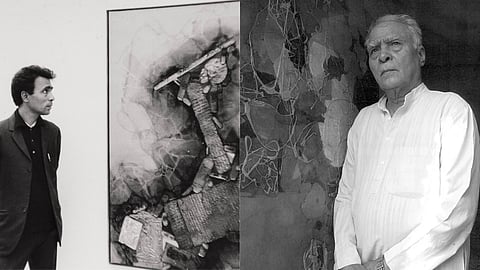
- HOMEGROWN WORLD
- #HGCREATORS
- #HGEXPLORE
- #HGVOICES
- #HGSHOP
- CAREERS
- ABOUT US
- CONTACT US

Shanti Dave, affectionately known as Shanti bhai in his artistic circles, came from the village of Badpura in North Gujarat. Later, life led him to the city of Ahmedabad, where he earned his livelihood by painting eye-catching signboards and billboards for local cinemas before he received formal education.
Regarded as India's pioneer of abstract expressionism, Dave once shared, “My paintings, with their pulsating energy, vibrant colours, and interesting textures, pay homage to the kala (art) of India. They are an ode to memories, to the sights and sounds of the ruins I absorbed as a child growing up in Gujarat.”
With his artistic expression, he encapsulated the essence of Gujarat, a place inexplicably tied into the fabric of his upbringing. It brimmed with the vitality of local activities, festivities, rituals, and lush vegetation. To translate this onto canvas, Dave carefully chose the encaustic medium, for he felt, this was the only medium to present his style of painting using richly textured work wax and cement, like embossing. His work is so detailed and his impressions are so vivid and intense that no one else can replicate his work once complete, himself included.
Embedded within Dave's art was a fascination with the concept of "akshara" or "the word". A recurring theme in Dave's work, this exploration permeates his visual language, embodying the theory of sound and the aesthetics of bhava; imbuing each composition with a distinct rasa. His use of a unique, untranslatable script derived from Devanagari and Nepalese languages places him at the forefront of calligraphic Modernism in the South Asian subcontinent of the 1960s. This script exudes an ancient aura, akin to stumbling upon a lost civilisation or looking at an otherworldly landscape.
He, moreover, brings all the elements of music onto his canvas, challenging the restrictions of visual medium, he translates the essence of music and composes a symphony of visual elements. In a candid interview, Dave articulated his profound connection to music, likening it to a divine force in the artistic process. He said, “In a fight between colours, texture, and abstraction, in it music becomes a divine element, and that divine element was a matter of great joy for me.”
Dave is not merely a painter; he is an architect of civilisations. His work bores a topography of rich, high-relief textures, a cartographic journey through his vision. Take, for instance, his "Untitled" from 1975 — a painting that unravelled like a map of some enigmatic land. Its textured surface, awash in muted hues, beckoned with an invitation to meditate, to wonder. Light and shadow danced upon it, revealing depths that were both startling and serene. Dave's paintings do not seek to assert; they are vessels of emotions too elusive for words or any other medium to capture.
None of his artworks have a name, he refrains from giving away titles that might confine their interpretations. He allowed his works to roam free in the imagination of his viewers, where they could be understood in countless and often contradictory ways.
Notably, his murals graced prominent Air India offices in major cities like London, New York, and Frankfurt, attesting to the global reach and impact of his art. His artistic concerns are firmly rooted in modernist sensibilities, evident in the deliberate use of formal abstraction within his works. Rather than emphasising ideological narratives, Dave places a significant emphasis on exploring the inherent potential of his chosen medium.
As his career progressed, Dave made a conscious shift towards printmaking, drawn to its inclusive nature that democratises the artistic process for both creator and audience alike. This choice is indicative of his inclination towards accessibility and a desire to break down barriers in art consumption. Additionally, printmaking opened up new avenues for Dave to experiment with textures, allowing him to push the boundaries of his artistic expression even further.
In 1964, the New York Times revealed a photograph in the cover page, titled "Little Gujarat", spanning three columns of its front page. For Shanti Dave, it was a moment of unparalleled joy, a fusion of his roots with the cosmopolitan world he now inhabited. In 2023, at 92, he remains a quiet titan and his brilliance, his style, and his technique remain peerless.
